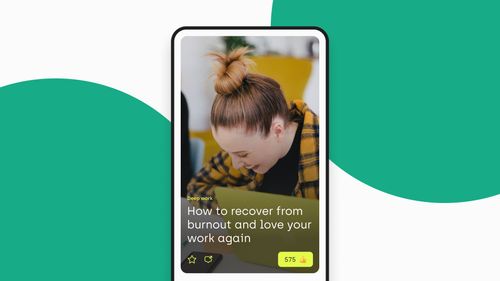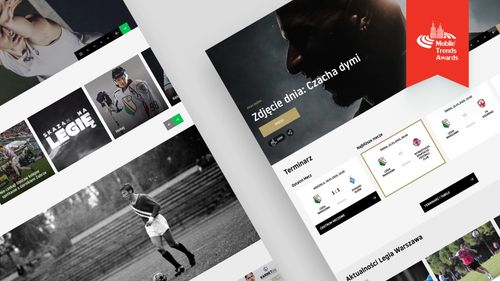The Flywheel Effect in Product Design
Anna Rózga
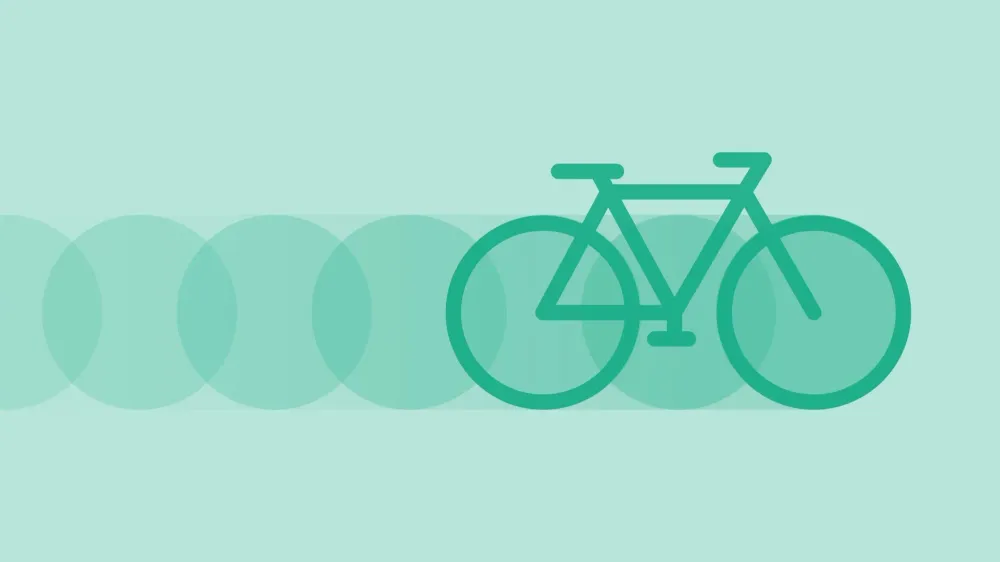
Let’s start with a little thought experiment. Have you ever tried riding a spin bike? The first push on the pedals is always the most challenging one, putting up the most resistance. However, as you slowly build up momentum, peddling is getting easier. The mechanism starts storing kinetic energy, spinning faster and faster with each turn. Suddenly, you catch yourself driving at full speed, powered purely by excess energy stored in the heavy wheel attached to the bike – an unassuming but powerful flywheel.
What if building a successful digital product is just like riding a spin bike? Sounds a bit silly, but many successful companies like Amazon base their operating cycle on a flywheel concept. They owe their unchallenged position on the market to it. So whether you’re a startup eager to start their engine or a growing company in search of a way to pick up speed, the flywheel effect holds the keys to your big breakthrough moment.
Jim Collins’ Flywheel Effect
The flywheel effect is a concept first introduced to the world by Jim Collins in his business philosophy book ‘Good to Great’. In it, he describes a phenomenon where small, consistent effort results in significant progress over time.
Collins’ concept is based on a mechanical device called a flywheel. Massive metal disk invented to generate, store, and transfer rotational energy. Once you apply the required force to set the device in motion, it uses kinetic energy to maintain and even increase its rotational speed, spinning effortlessly by itself. A flywheel serves as a comparatively low-powered motor for a variety of mechanisms, raging from simple pottery wheels to complex car engines.
Similarly, in business context, the flywheel effect occurs when small wins accumulate over time, creating a positive feedback loop that accelerates the company’s growth. According to Collins, putting in sustained, consistent effort builds up momentum that drives you towards market success. After the breakthrough moment, your business reaches a point where the output greatly exceeds the input, allowing you to reach new heights powered only by the flywheel’s stored energy.
Flywheel Effect in Product Design
The flywheel concept can be applied to product development to create exceptional digital experiences that turn into profit. Here, at hero/dot, we tap into this business philosophy by adopting a circular rather than linear approach to the process. Our multidisciplinary team of experts has perfected this loop of iterative refinement.
Simply put, with a focus on adding incremental changes we are able to achieve significant improvements in user experience, engagement and product marketability. Let’s take a look at our process, shall we?
Idea & Concept
Whether you have a specific plan or a general concept in mind, your idea needs to undergo some fine-tuning in order to uncover the most effective solution. Let’s start with identifying the problem. Empathizing with your customers and getting to know your individual business needs during client workshops. Once we’ve defined the opportunity for innovation, we move to the next stage with a clear understanding of the new direction for our flywheel.
Research & Strategy
Now it’s time to put the gut feeling to the test by conducting competitive analysis and researching your target audience. Our business analysts validate the chosen direction, identify the right market gap for your product, and come up with a Unique Value Proposition. During this stage, it is crucial to think long-term and develop a growth plan with achievable milestones. Those small wins cumulate and turn into the required energy for your flywheel to pick up momentum and drive long-term success. You can read more about business analysis process here.
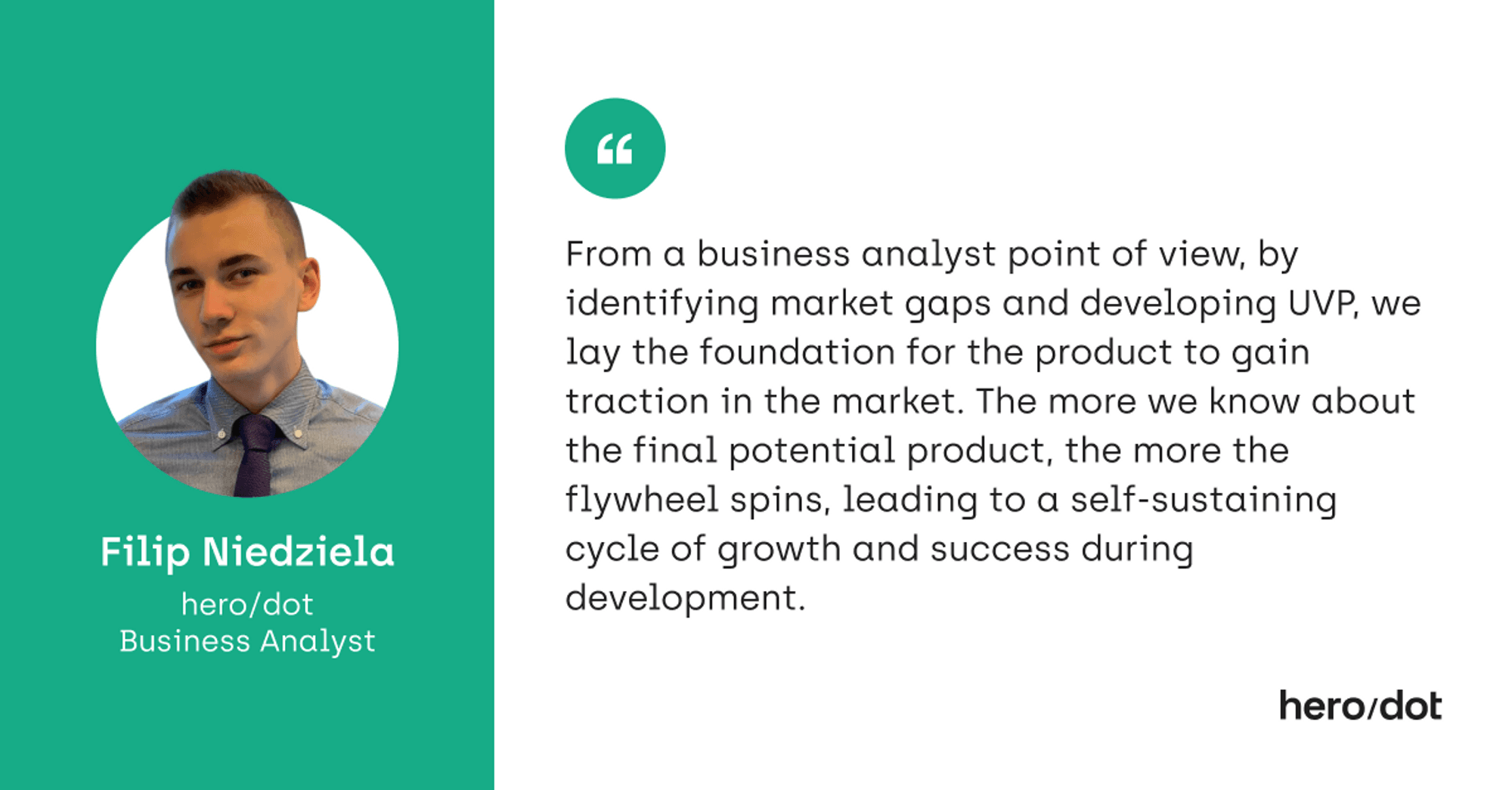
Design & Development
Whether it’s crafting stunning UI prototypes, writing a clear and concise microcopy or choosing the right technology stack, our team brings their expertise to the table. Each creative decision or developed solution is a way to apply force to the mechanism. Additionally, addressing bugs, issues or shortcomings removes friction. By cutting short any hanging threads, we can finally start releasing energy provided by previously applied force.
Launch & Evaluation
This is the breakthrough moment, when you introduce the world to your product with a successful and disruptive launch. But the process doesn’t end after releasing the Minimum Variable Product. For the flywheel to start spinning with full speed, it needs continuous refinement. By gathering customer feedback and identifying areas for improvement, you can fix any remaining bugs, add new profitable features and tweak user experience to truly delight your customers. Following the growth plan creates a positive feedback loop that has the power to drive your success.
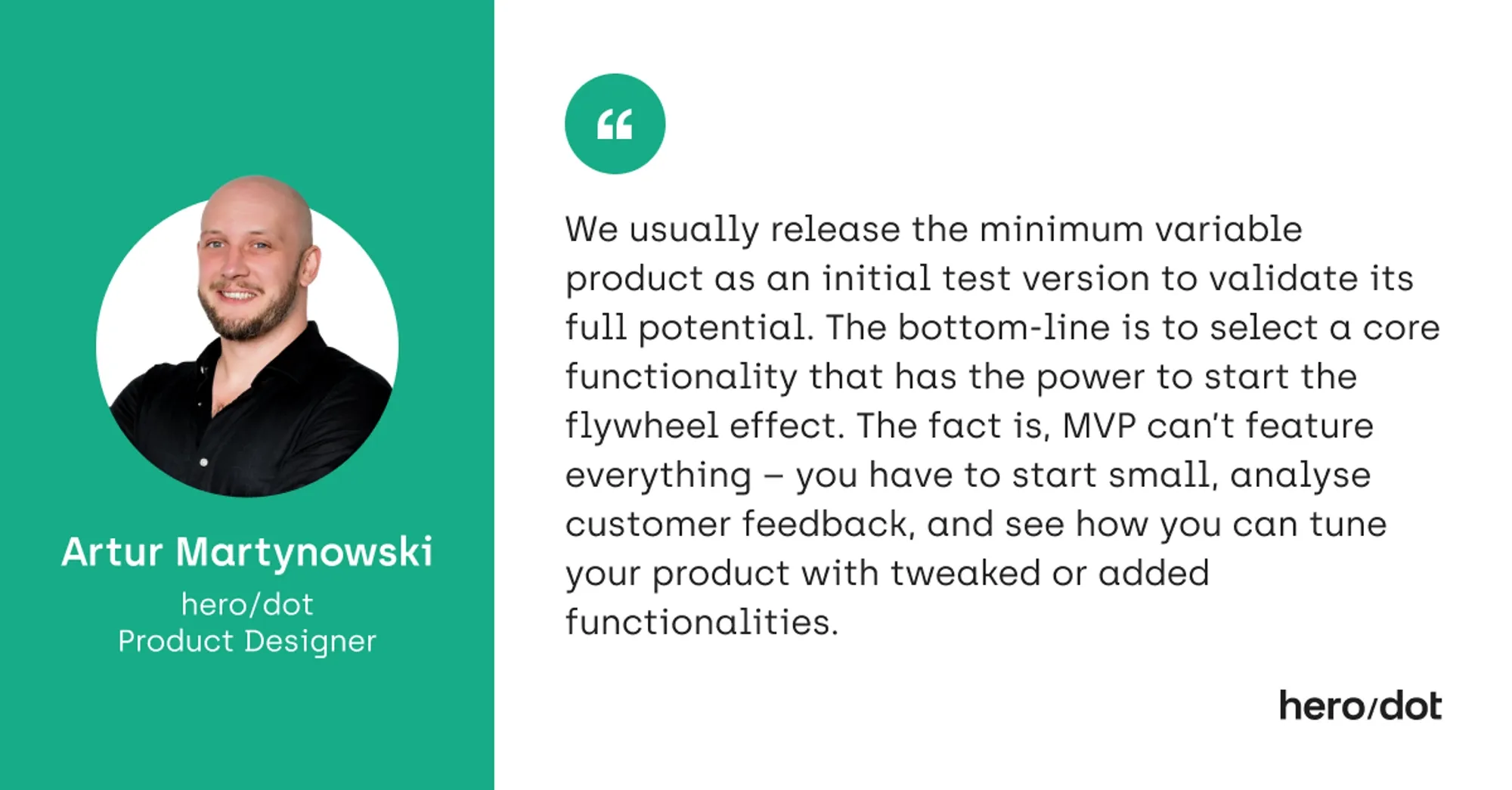
…& Repeat!
Once you have made improvements, relaunch the product and start the cycle again. Each loop builds up energy and leads to a better product over time.
How does it work?
Removing Friction
First rule of achieving a flywheel effect – eliminate all resistance. For a product designer, it means getting rid of most obstacles and barriers that stand on the user’s way to the conversion point. For example, intuitive information architecture and concise UX writing allow for a smooth rotation of the flywheel.
Applying Force
Once you removed resistance, it’s time to apply appropriate force to introduce more energy to the system. Measures, such as SEO copywriting or proper user engagement strategy, have the power to fuel your digital product’s success. The more types of force you apply, the faster your company will get its breakthrough moment.
Momentum
The law of inertia is the concept that an object will continue in its existing state of rest or current motion, unless changed by an external force. Sure, you need consistent effort to get the mechanism going, but once you build up enough momentum, there’s not much that can stop you from spinning!
Direction
The most common cause of seeing disappointing results is failing to develop a growth plan in advance. A clear set of business objectives allows your company to focus efforts in one direction to get the desired outcome. Instead of wasting misplaced resources, let’s concentrate on selecting a core functionality, developing your product’s MVP and building up from there.
Positive Feedback Loop
What’s that, you ask? A positive feedback loop amplifies or reinforces an initial change, leading to exponential growth or acceleration. For example, on social media, a post that receives many likes is more likely to be recommended to other users, which, in turn, results in even more engagement. These self-perpetuating cycles can be beneficial or detrimental, depending on how well we understand the dynamics and use them to our advantage. That’s why it’s crucial for a company to monitor changes and take steps to manage them when necessary.
The ‘Attract – Engage – Delight’ Principle
Remember how we established that applying several forces to the flywheel amplifies the effects? That’s precisely why product development goes hand in hand with engagement design and marketing. By adopting the ‘Attract – Engage – Delight’ principle, you can win over your target audience. Turning their engagement into positive energy to power up your flywheel.
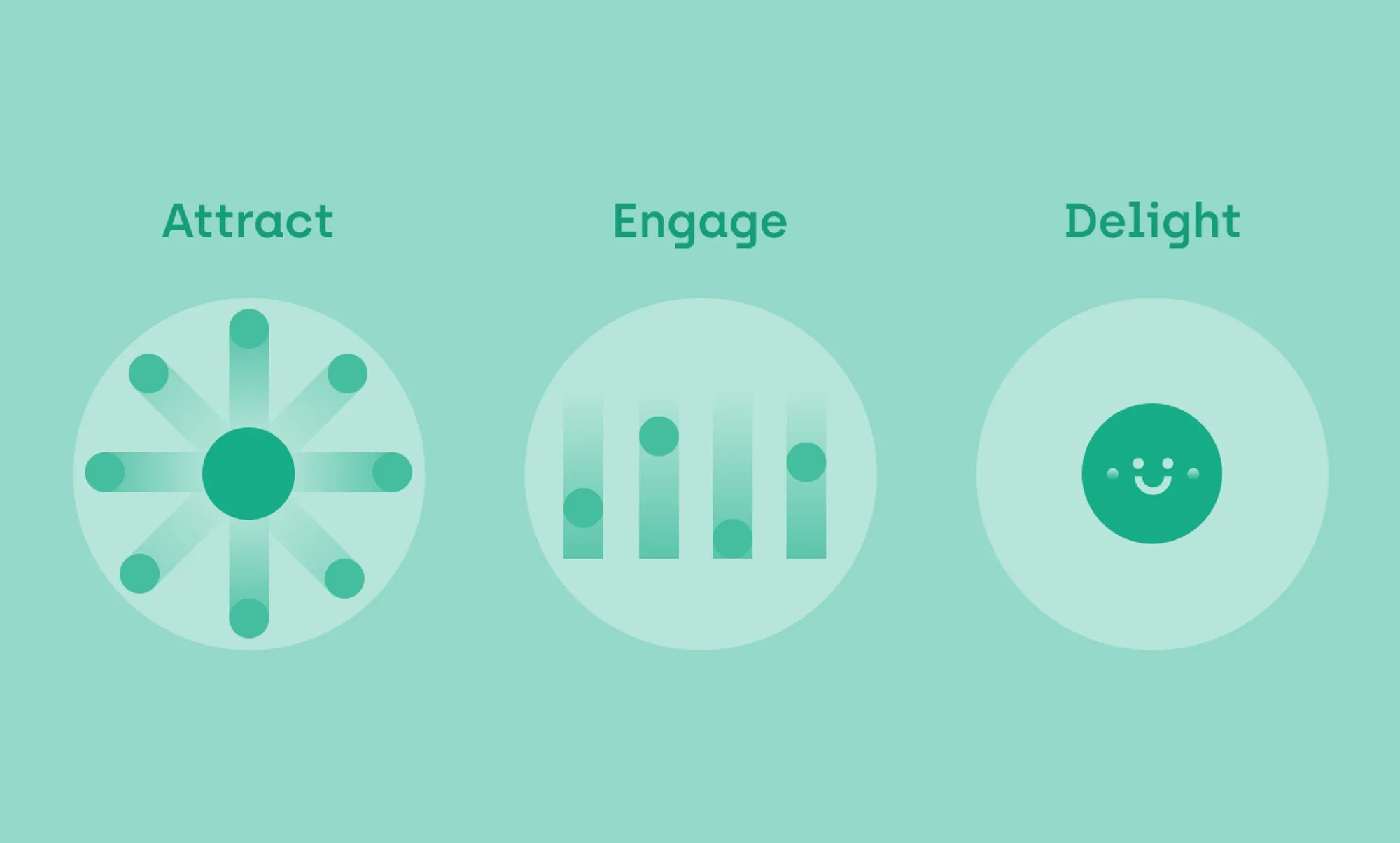
Attract
In our experience, an effective landing page is one of the most efficient tools for kick-starting marketing efforts. It’s best to develop the website alongside the product it promotes. Releasing the website before the product launch increases the chances for success and helps you attract potential customers. Focus on clear information architecture and helpful content, and let the landing page work its magic.
Engage
What a better way to engage your audience than to create a Community Ecosystem. Imagine your users, sponsors, partners, and ambassadors all connecting together over shared values, lifestyles or beliefs. Such a loop of never-ending, genuine interactions can even operate as its own flywheel!
Delight
The goal is to provide your users with exceptional service and positive experience at every touchpoint. That’s why it’s so important to take in customer feedback and act on it. User Engagement is a service that focuses on verifying, refining and optimizing your digital solution. That turns your customers into brand advocates, who will recommend the product to their friends, family and even strangers.
Conclusion
Just like many other successful businesses, you can take advantage of Jim Collins’ business philosophy and apply the flywheel effect at every stage of the product design process. With an iterative approach, small wins accumulate over time, leading to grand results. Removing friction, applying force and building up momentum in one direction creates a positive feedback loop that boosts your company into commercial success. And on top of that, you can attract, engage and delight your users and turn their positive digital experiences into profit.
Have an idea for a digital product? Contact our multidisciplinary team of experts today!
Need expert assistance with your digital project?
